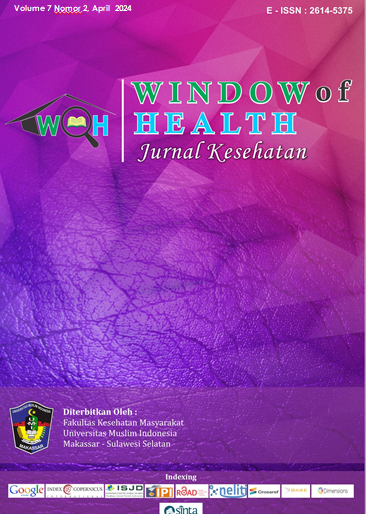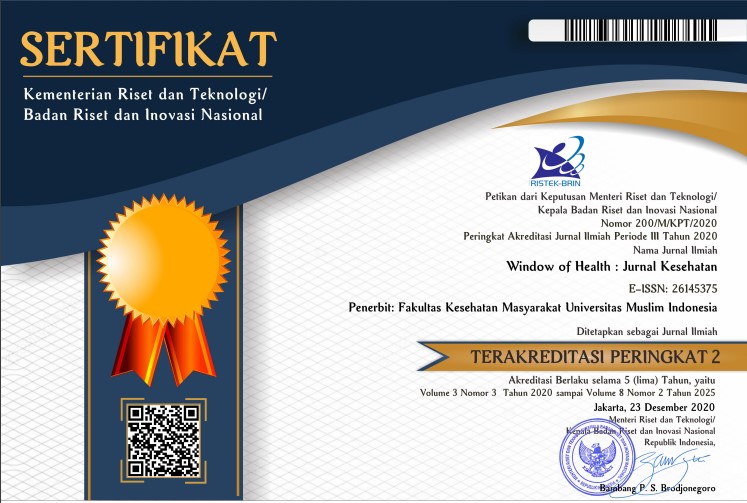Determinants of Toddlers’ History with Stunting Incidence in the Coastal Community
Abstract
The main nutritional problem in toddlers that is still commonly found in many countries around the world is stunting. Stunting is a chronic nutritional problem caused by long-term malnutrition. Infectious diseases and malnutrition can cause stunting. The aim of the study was to determine the relationship between the history of children and the incidence of stunting in the people of the Coastal Village of Kamarian. This research is an analytic survey research with a cross sectional design. This research was carried out on June 1 -31 2022. The sample in this study was 113 toddlers aged 2-5 years using total sampling. This study uses the Chi-Square test. The results showed that there were 22.9% (27 children) who were stunted. There is a relationship between birth weight (ρ=0.000), exclusive breastfeeding (ρ=0.013), infectious diseases (ρ=0.000), complementary feeding (ρ=0.002) and stunting. Low birth weight, exclusive breastfeeding, infectious diseases, and early complementary feeding (MP-ASI) can affect the incidence of stunting in children.
References
N. Khairani and S. U. Effendi, “Family characteristics as risk factors of stunting among children age 12-59 month,” J. Aisyah J. Ilmu Kesehat., vol. 4, no. 2, pp. 119–130, 2019.
G. Danaei et al., “Risk Factors for Childhood Stunting in 137 Developing Countries: A Comparative Risk Assessment Analysis at Global, Regional, and Country Levels,” PLoS Med., vol. 13, no. 11, pp. 1–18, 2016.
UNICEF, WHO, and W. Bank, “Levels and trends in child malnutrition; UNICEF/WHO/World Bank Group-Joint child malnutrition estimstes 2021 edition,” p. 32, 2021.
World Health Organization, “Stunting prevalence among children under 5 years of age (%) (model-based estimates),” 2022. [Online]. Available: https://www.who.int/data/gho/data/ indicators/indicator-details/GHO/gho-jme-stunting-prevalence.
Kementerian Kesehatan RI, Buku Saku Hasil Studi Status Gizi Indonesia (SSGI) Tingkat Nasional, Provinsi, dan Kabupaten/Kota Tahun 2021. Jakarta: Kementerian Kesehatan RI Badan Penelitian dan Pengembangan Kesehatan, 2021.
Kemenkes RI, Profil Kesehatan Indonesia Tahun 2019. 2020.
Dinas Kesehatan Kabupaten Seram Bagian Barat, Publikasi Hasil Pengukuran Balita Tingkat Kabupaten. Piru, 2021.
E. Nasution, Darwin, Detty Siti Nurdiati, Huriyati, “Berat badan lahir rendah (BBLR) dengan kejadian stunting pada anak usia 6-24 bulan,” J. Gizi Klin. Indones., vol. 11, no. 1, pp. 31–37, 2014.
L. M. García Cruz, G. González Azpeitia, D. Reyes Súarez, A. Santana Rodríguez, J. F. Loro Ferrer, and L. Serra-Majem, “Factors associated with stunting among children aged 0 to 59 months from the central region of Mozambique,” Nutrients, vol. 9, no. 5, pp. 1–16, 2017.
S. G. Ria Astuti, Neneng Martini, M. Wijaya, and A. Mandiri, “Risiko Faktor Ibu terhadap Kejadian Stunting,” J. Kebidanan Malahayati, vol. 7, no. 4, pp. 842–850, 2021.
S. S. Halli, R. A. Biradar, and J. B. Prasad, “Low Birth Weight, the Differentiating Risk Factor for Stunting among Preschool Children in India,” Int. J. Environ. Res. Public Health, vol. 19, no. 7, 2022.
A. Nshimyiryo et al., “Risk factors for stunting among children under five years: A cross-sectional population-based study in Rwanda using the 2015 Demographic and Health Survey,” BMC Public Health, vol. 19, no. 1, pp. 1–10, 2019.
M. L. K. Addinia, Nida, “ASI Eksklusif Sebagai Pencegahan Stunting di Kabupaten Flores Timur,” J. Penelit. Kesehat. Suara Forikes, vol. 13, no. 3, pp. 694–698, 2022.
M. R. Permadi, D. Hanim, K. Kusnandar, and D. Indarto, “Risiko Inisiasi Menyusu Dini Dan Praktek Asi Eksklusif Terhadap Kejadian Stunting Pada Anak 6-24 Bulan (Early Breastfeeding Initiation and Exclusive Breastfeeding As Risk Factors of Stunting Children 6-24 Months-Old),” Penelit. Gizi dan Makanan (The J. Nutr. Food Res., vol. 39, no. 1, 2017.
S. Sumiyati, “Berat bayi lahir rendah dan ASI eksklusif terhadap kejadian stunting pada balita,” J. Ris. Kebidanan Indones., vol. 6, no. 1, pp. 1–5, 2022.
T. Subroto, L. Novikasari, and S. Setiawati, “Hubungan Riwayat Penyakit Infeksi Dengan Kejadian Stunting Pada Anak Usia 12-59 Bulan,” J. Kebidanan Malahayati, vol. 7, no. 2, pp. 200–206, 2021.
E. Lidia Fitri, “Hubungan Pemberian Asi Eksklusif dan Mp Asi Dini dengan Kejadian Stunting pada Balita,” Al-Insyirah Midwifery J. Ilmu Kebidanan (Journal Midwifery Sci., vol. 8, no. 1, p. 2024, 2019.
et al. Kuchenbecker J, Jordan I, Reinbott A, Herrmann J, Jeremias T, Kennedy G, “Exclusive breastfeeding and its effect on growth of Malawian infants: results from a cross-sectional study,” Paediatr. Int. Child Health, vol. 35, no. 1, pp. 14–23, 2015.
D. P. Khasanah, H. Hadi, and B. A. Paramashanti, “Waktu pemberian makanan pendamping ASI (MP-ASI) berhubungan dengan kejadian stunting anak usia 6-23 bulan di Kecamatan Sedayu,” J. Gizi dan Diet. Indones. (Indonesian J. Nutr. Diet., vol. 4, no. 2, p. 105, 2016.
Copyright (c) 2024 Mariene Wiwin Dolang, Anastasya Pelamonia, Yohanes Friyedo Simanjuntak

This work is licensed under a Creative Commons Attribution-NonCommercial-ShareAlike 4.0 International License.








